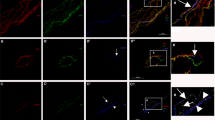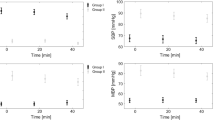Abstract
IRIS colour to some degree depends on the sympathetic innervation of the eye. Chance clinical observations of humans and experimental studies in animals have demonstrated consistently a gradual lessening of colour intensity in the iris after interruption of the sympathetic pathways to the eye1,2. Similarly, full iris pigmentation fails to develop when the sympathetic innervation to the eye is absent from birth3. Interest in the relationship of sympathetic innervation to iris colour has increased with reports of direct adrenergic innervation to iris stromal melanocytes4–6. For mammals this is extraordinary in that most melanocytes, for example those of the skin, have no innervation. We have investigated this relationship using tyrosinase activity as an index of melanin synthesis since melanin is the chief pigment of the iris and tyrosinase is the rate-limiting enzyme in the production of melanin7. In turn, iris tyrosinase activity was measured in normal rabbits and in rabbits in which the sympathetic pathways to the eye have been interrupted.
This is a preview of subscription content, access via your institution
Access options
Subscribe to this journal
Receive 51 print issues and online access
$199.00 per year
only $3.90 per issue
Buy this article
- Purchase on Springer Link
- Instant access to full article PDF
Prices may be subject to local taxes which are calculated during checkout
Similar content being viewed by others
References
Calhoun, F. P., Am. J. Ophthal., 2, 255–269 (1919).
Angelucci, A., Archo. Ottal., 1, 3–14 (1893).
Gladstone, R. M., Archs Neurol. Chicago, 21, 184–191 (1969).
Ehinger, B., Z. Zellforsch. mikrosk. Anat., 116, 157–177 (1971).
Ehinger, B., and Falck, B., Z. Zellforsch. mikrosk. Anat., 105, 538–542 (1970).
Laties, A. M., Invest. Ophthal., 7, 555–584 (1972).
Nicolaus, R. A., Melanins (Herman, Paris, 1968).
Cannon, W. B., and Rosenblueth, A., Supersensitivity of denervated structures a Law of Denervation (Macmillan, New York, 1949).
Pomerantz, S. H., Biochem. biophys. Res. Commun., 16, 188–194 (1964).
Zinn, K. M., Mockel-Pohl, S., Villanueva, V., and Furman, M., Am. J. Ophthal., 76, 721–729 (1973).
Olson, R. L., Nordquist, N., and Everett, M. A., Br. J. Derm., 83, 189–199 (1970).
Ohtaki, N., and Seiji, M., J. Invest. Derm., 57, 1–5 (1971).
Klein, D. C., Weller, J. L., and Moore, R. Y., Proc. natn. Acad. Sci. U.S.A., 68, 3107–3110 (1971).
Volkman, P. H., and Heller, A., Science, 173, 839–840 (1971).
Author information
Authors and Affiliations
Rights and permissions
About this article
Cite this article
LATIES, A., LERNER, A. Iris colour and relationship of tyrosinase activity to adrenergic innervation. Nature 255, 152–153 (1975). https://doi.org/10.1038/255152a0
Received:
Revised:
Issue Date:
DOI: https://doi.org/10.1038/255152a0
This article is cited by
-
Segmental vitiligo in a patient with thoracic outlet syndrome
Rheumatology International (2012)
-
Clinical and morphological features of Waardenburg syndrome type II
Eye (1998)
-
The occurrence of cutaneous nerve endings and neuropeptides in vitiligo vulgaris: a case-control study
Archives of Dermatological Research (1996)
-
Gossypol effects on cultured normal and malignant melanocytes
In Vitro Cellular & Developmental Biology (1986)
-
Innervation of melanocytes in human iris
Albrecht von Graefes Archiv f�r Klinische und Experimentelle Ophthalmologie (1977)
Comments
By submitting a comment you agree to abide by our Terms and Community Guidelines. If you find something abusive or that does not comply with our terms or guidelines please flag it as inappropriate.



